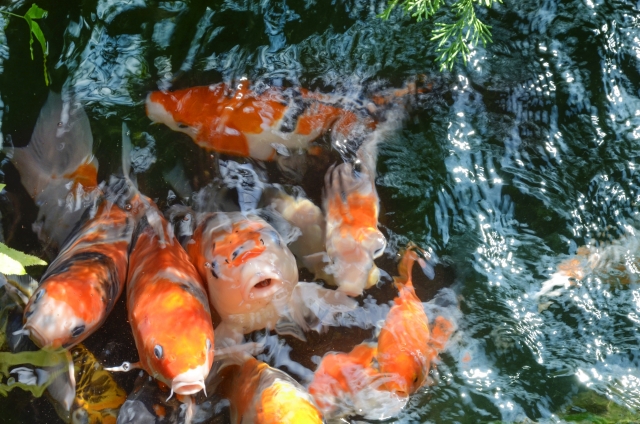I’m writing this blog in order to design a world like a kaleidoscope, and this is 272nd post. I’ve intertwined 272 facets of different expressions. Revolving and spinning around like a kaleidoscope, and weaving up exceptional motifs. If this blog can give a relief and amuse readers who are surviving through this excruciatingly tough world, it will be my utmost pleasure.
万華鏡の様な世界観を構築したいと思い書いているこのブログ、これで272本目の記事の更新となる。これまでに272の切り子面を展開させて来たのだ。万華鏡の様に変幻自在にクルクルと周り回って、珍かな紋様を浮かび上がらせ、そうすることで読む方の憂世の辛さを少しでも和らげ、楽しませることが出来たなら、私としても嬉しいです。
Meanwhile, I’d like to pick up a high school Japanese history textbook published by Yamakawa. I took world history course for social studies in high school and didn’t study deeper level of Japanese history: I was fully aware of the lack of absolute knowledge. That’s one reason why I majored Japanese Cultural Heritage and Traditional Arts in the graduate school in Kyoto. However, there’re blind spots here and there. So I bought this catalogue (376 pages with full color pics for 990 yen!) to supplement the blanks. Flipping through pages full of photos with intriguing explanations when free.
さてさて、今回は日本史概略について。高校の日本史教材として使われている山川出版の『詳説日本史図録』を取り上げたい。私自身、高校では社会科は世界史を選択したので、日本史については深く学んでおらず、絶対的な知識量が足りていないと実感して来た。それもあったので、京都の大学院では日本の文化遺産・伝統芸術を専攻して学び直しを図ったわけだ。それでも色々と穴があり、そこを補おうとこの日本史図録(376ページ、オールカラー、税込で990円!)を購入して、暇な折に眺めている。写真満載で尚且つディープな深掘りもあり、とっても面白い。
And put Post It on pages featuring places I’ve visited, artworks that I actually appreciated, and literature I read and studied. Japanese Culture Dissemination is my speciality, so I keep on making a research. And walking along while pondering what to focus, what to mix up, and what to write about, looking up the sky far to reach out. And I pray that Japanography to become one facet of Japanology.
そして、この図録に取り上げられていたもので、これまでに行った場所、この目で鑑賞した美術作品、読み学んだものについて、付箋を貼ってみた。日本文化発信が私の専門となるので、これからも研究は続いてゆく。そして何を取り上げ、何と掛け合わせて、どんな形で書き綴って行こうかと空に思いを放ってテクテクと歩く道である。そして、ジャパノグラフィー®︎が日本学の一つの切り子面となって行きます様に!
<Places>
*Asakusa Sensoji Temple, Nakamise, Ginza
*Nara Horyu Ji Temple, Kofuku Ji Temple, Todai Ji Temple (Nandaimon Gate, Daibutsu Den The Great Buddha Sanctuary, Shosoin Repository, Nagitsu Doh), Kasuga Taisha Shrine
*Kyoto Ginkaku Ji Temple, Shimogamo Shrine, Kiyomizu Dera Temple, Tenryu Ji Temple, Nijo Jo Castle, Kinkaku Ji Temple, Ryoan Ji Temple
*Hiroshima Atomic Bomb Dome, Itsukushima Shrine
*Nikko Tosho Gu Shrine
*Shimane Iwami Silver Mine
*Mt. Fuji
*Meiji Japan Industrial Revolution Ruins, Glover Garden, Yahata Seitetsu Steel Company, Manda Ko Cola Mine Shaft, Shokason Jyuku School, Hagi Castle Down Town, Hagi Reverberatory Furnace, etc
*The National Museum of Western Art (architecture of Le Corbusier)
*Fukuoka Munakata Taisha Shrine, Takamiya Ancient Ritual Sanctuary, Nuyama Ancient Tomb.
*Hidden Christian related ruins, Ohura Cathedral, Nagasaki Hirado area
*Saga Yoshinogari Ruins believed to be Ancient Yama Taikoku
*Fukuoka Takehara Ancient Tomb
*Fukuoka Hakozaki Gu Shrine relating to Mongol Invasion Attempt
*Nagasaki Dejima, 26 Saints Martyr Site, Kameyama Shachu Cooperate, Tojin Yashiki Ato, Nagasaki Kofuku Ji Temple, Urakami Cathedral, Sasebo Port
*Kumamoto Kikuchi Castle Ruins
*Kamakura Tsuruoka Hachiman Gu Shrine, the Great Buddha, Kencho Ji Temple
*Chiba Inba Numa Swamp
*The University of Tokyo Red Gate, Keio University, Kyushu University, Tsuda Juku University, Doshisha University, Gakushuin University, Hose University
*Tokyo Rikugi En Garden, Koishiwara Kourakuen Garden
<行った場所>
*浅草浅草寺、仲見世、銀座
*奈良の法隆寺、興福寺、東大寺(南大門、大仏殿、正倉院、二月堂)、春日大社
*京都の銀閣寺、下鴨神社、清水寺、天龍寺、二条城、金閣寺、龍安寺
*広島原爆ドーム、厳島神社
*日光東照宮
*島根石見銀山
*富士山
*明治日本の産業革命遺産、グラバー園、八幡製鐵所、万田坑、松下村塾、萩城下町、萩反射炉など
*国立西洋美術館(ル・コルビュジエの建築作品)
*「神宿る島」福岡の宗像大社、古代祭祀が行われた高宮斎場、奴山古墳群
*潜伏キリシタン関連遺産、大浦天主堂、長崎平戸地域
*邪馬台国説のある佐賀吉野ヶ里遺跡
*福岡、竹原古墳
*蒙古襲来に関する福岡の筥崎宮
*長崎出島跡、26聖人殉教地、亀山社中、唐人屋敷跡、長崎興福寺、浦上天主堂、佐世保港
*熊本鞠智(きくち)城跡
*鎌倉の鶴岡八幡宮、大仏、建長寺
*千葉印旛沼
*東京大学赤門、慶應義塾大学、九州大学、津田塾大学、同社社大学、学習院大学、法政大学
*東京の六義園、小石川後楽園
<Art Works, Traditional Art, and Old Currency>
*National Treasure Genji Monogatari Emaki
*Kabuki
*Takao Kanpuzu Byoubu
*Ukiyoe Woodblock Prints (Suzuki Harunobu, Toshusai Sharaku, Katsushika Hokusai, Utagawa Hiroshige)
*Ohbakushu Ingen Ryuki Hanging Scroll
*Dutch East India Company Plates
*Hakata Ori Textile, Arita Pottery, Kurume Gasuri Textile, Mino Pottery, Hagi Pottery, Seto Pottery, Kutani Pottery, Kyoto Nishijin Ori Textile
*Nara Kofuku Ji Temple Yamada Dera Buddha Head, Ashura Statue, Hachibushu Statues, Jyudai Deshi Statues, Tento Ki Statue, Ryuto Ki Statue, etc
*Nara Todaiji Temple Nandai Mon Gate Kongou Rikishi Statues; Agyo and Ungyo, Kaidan Dou Shitennou Statues, Chokei Shonin Statue, etc
*10 Yen Bill when The Currency Law was enacted in 1897
*Coal Mine Recording Paintings of Yamamoto Sakubei
*Artworks of Takehisa Yumeji
<鑑賞した美術作品や伝統芸能や古いお金>
*国宝源氏物語絵巻
*歌舞伎
*高雄観楓図屏風
*浮世絵(鈴木春信、東洲斎写楽、葛飾北斎、歌川広重)
*黄檗宗隠元隆琦の掛け軸画
*オランダ東インド会社の皿
*博多織、有田焼、久留米絣、美濃焼、萩焼、瀬戸焼、九谷焼、京都西陣織
*奈良興福寺の山田寺の仏頭、阿修羅像、八部衆像、十大弟子像、天灯鬼像、竜灯鬼像などなど
*奈良東大寺南大門金剛力士像の阿形(あぎょう)と吽形(うんぎょう)、戒壇堂四天王像、重源上人像などなど
*1897年貨幣法が制定された時の十円札
*山本作兵衛の炭鉱記録画
*竹久夢二の作品の数々
<Literature and Academic Thesis>
*thesis regarding Edo Zu Byubu
*Court Literature of Heian Era (late 8 C.~late 12 C.) ‘The Tale of Genji’ original script of Lady Murasaki, Yosano Akiko modern translation, English translation by Suematsu Kencho of Kitamura Kigin Digest version Kogetsu Sho/ ‘The Diary of Lady Murasaki’ Lady Murasaki original script, modern translation, English translation/ ‘The Pillow Book’ Lady Sei Shonagon original script, modern translation, English translation/ ‘Sarashina Nikki Diary’ Sugawarano Takasue no Musume original script, Ekuni Kaori modern translation
*thesis regarding Shigisanengiemaki
*thesis regarding Moko Shurai Ekotoba; Mongol Invasion Attempt Ekotoba
*plenty of thesis regarding Okakura Kakuzo
*’Tsurezure Gusa; Essays in Idleness’ written by Kenko translated by Donald Keene
* ‘Wakana Shu’ Shimazaki Toson, ‘Mai Hime’ Mori Ohgai, ‘Takekurabe’ Higuchi Ichiyo, ‘Kokoro’ ‘Wagahai wa Neko dearu; I Am a Cat’ Natsume Soseki, ‘Chijin no Ai’ ‘Shunkinsho’ Tanizaki Junichiro, ‘Rashomon’ Akutagawa Ryunosuke, ‘Izu no Odoriko; The Izu Dancer’ ‘Yukiguni; Snow Country’ Kawabata Yasunari, ‘Horoki’ Hayashi Fumiko, ‘Ginga Tetsudo no Yoru’ Miyazawa Kenji, ‘Shayou’ Dazai Osamu, ‘Kamen no Kokuhaku: Confessions of a Mask’ Mishima Yukio, ‘Darakuron’ Sakaguchi Ango, ‘Futon’ Tayama Katai
<読み学んだ文献など>
*江戸図屏風に関する論文
*平安の王朝文学では、『源氏物語』紫式部の原文と与謝野晶子訳と北村季吟の注釈書である源氏物語湖月抄の末松謙澄の英訳、『紫式部日記』原文と英訳、『枕草子』清少納言の原文と現代語訳と英訳、『更級日記』菅原孝標女の原文と江國香織訳
*信貴山縁起絵巻に関する論文
*蒙古襲来絵詞に関する論文
*岡倉天心に関する論文多数
*『徒然草』兼好法師が書いた原文をドナルド・キーンが英訳したもの
*『若菜集』島崎藤村、『舞姫』森鴎外、『たけくらべ』樋口一葉、『こころ』『吾輩は猫である』夏目漱石、『痴人の愛』『春琴抄』谷崎潤一郎、『羅生門』『鼻』芥川龍之介、『伊豆の踊り子』『雪国』川端康成、『放浪記』林芙美子、『銀河鉄道の夜』宮沢賢治、『斜陽』太宰治、『仮面の告白』三島由紀夫、『堕落論』坂口安吾、『蒲団』田山花袋
Having eyes of a bird and overlooking from the sky, or wearing eyes of an insect getting closer maximumly, this attempt of depicting Japanese culture in bilingual switching over various lens is the supreme intellectual play that I invented. And praying this activity wins citizenship and prevails the globe and becomes inspirations for something good.
鳥の目になって空高くから俯瞰したり、虫の目となって近く近くににじり寄ったり、色んな目を持って日本文化をバイリンガルで書いて行くという試みは、私が編み出した知的遊戯の粋なのです。そしてこの活動が市民権を持って広がって行き、皆さんにとって何かの佳き着想の源となれば嬉しいです。
Love and Peace.
参考文献
『山川 詳説日本史図録(第10版)』編者 詳説日本史図録編集委員会、山川出版社、2023年3月






















